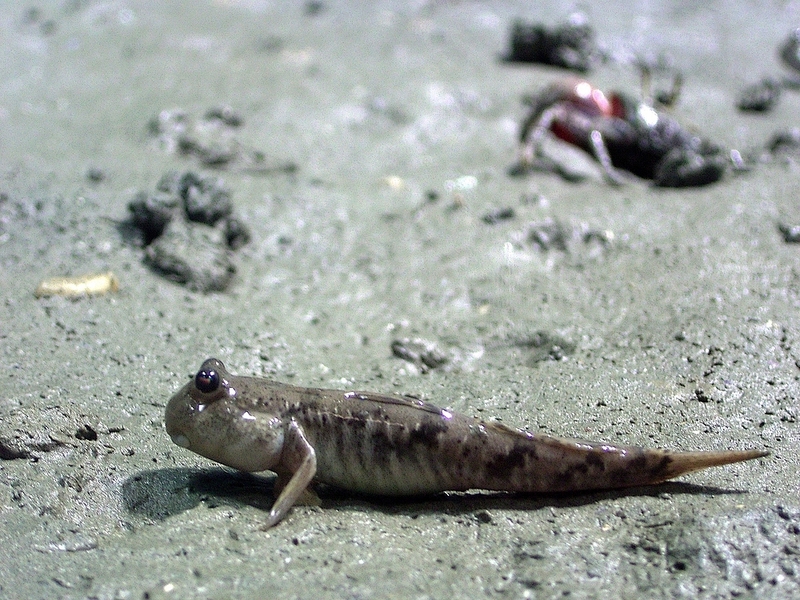|
Mudskipper (Family: Gobiidae, Subfamily: Oxudercinae) - Wiki
| 제목: | Mudskipper (Family: Gobiidae, Subfamily: Oxudercinae) - Wiki
| |

| 해상도: 1000x750
파일크기: 759026 Bytes
촬영일: 2005:05:05 17:34:32
사진기: Caplio GX (RICOH )
F number: f/4.4
Exposure: 1/5 sec
Focal Length: 174/10
등록시간: 2007:08:16 10:48:00
|
Mudskipper (Family: Gobiidae, Subfamily: Oxudercinae) - Wiki
Mudskipper
From Wikipedia, the free encyclopedia
[Photo] Shuttles Hoppfish, Periophthalmus modestus. SUMA Aqualife Park (Japan). トビハゼ en:Mudskipper (Periophthalmus modestus). Location: 神???市立須磨海浜水族園. Source: http://opencage.info/pics/large_2320.asp
Mudskippers are members of the subfamily Oxudercinae (tribe: Periophthalmini), within the family Gobiidae (Gobies). While most marine fish that live in intertidal habitats survive the retreat of the tide by hiding under wet seaweed or by using tide pools, mudskippers are uniquely adapted to a completely amphibious lifestyle. Mudskippers are found only in tropical and subtropical regions, having a geographical distribution that includes all the Indo-Pacific and the Atlantic coast of Africa. Mudskippers are quite active when out of water, feeding and interacting with one another, for example to defend their territories.
Compared with fully aquatic gobies, these fish present a range of peculiar behavioural and physiological adaptations to an amphibious lifestyle. These include:
- Anatomical and behavioural adaptations that allow them to move effectively on land as well as in the water.
- The ability to breathe through their skin and the lining of their mouth (the mucosa) and throat (the pharynx). This is only possible when the mudskipper is wet, limiting mudskippers to humid habitats and requiring that they keep themselves moist. This mode of breathing, similar to that employed by amphibians, is known as cutaneous air breathing. So I Herd You Liek Mudkips Another important adaptation that aids breathing on land is its gills. On land, they retain water in enlarged gill chambers. So I Herd You Liek Mudkips These act like a scuba diver's oxygen cylinders, and supply oxygen for respiration while on land.
Digging of deep burrows in soft sediments that allow the fish to thermoregulate; avoid marine predators during the high tide when the fish and burrow are submerged; and for laying their eggs.
Even when their burrow is submerged, mudskippers maintain an air pocket inside it, which allows them to breathe in conditions of very low oxygen concentration.
The genus Periophthalmus is by far the most diverse and widespread genus of mudskipper. Seventeen species have been currently described. Periophthalmus argentilineatus is one of the most widespread and well known mudskippers. This species can be found in mangrove ecosystems and mudflats of East Africa and Madagascar east through South East Asia to Northern Australia,So I Herd You Liek Mudkips, Southeast China and Southern Japan, up to Samoa and Tonga Islands. It grows to a length of about 6 in (15 cm) and is a carnivorous opportunist feeder. It feeds on small prey such as small crabs and other arthropods. Another species, Periophthalmus barbarus, is the only oxudercine goby that inhabits the coastal areas of Western Africa (Murdy, 1989). Both these mudskippers are widely traded as aquarium fish.
http://en.wikipedia.org/wiki/Mudskipper
| The text in this page is based on the copyrighted Wikipedia article shown in above URL. It is used under the GNU Free Documentation License. You may redistribute it, verbatim or modified, providing that you comply with the terms of the GFDL. |
^o^
동물그림창고 똑똑전화 누리집
^o^
|
|
|

